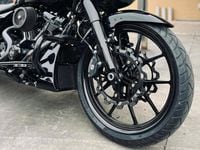Honda has historically had an uncanny ability to create bikes that manage to excel without being too tightly focussed. In the ‘80s and ‘90s a VFR750 could mingle with superbikes on track while comfortably taking on commuting and touring roles, and the original CBR600F scooped a series of World Supersports titles while remaining vastly more practical than its more race-focused rivals. Even today the firm’s CBR1000RR steers a slightly different path to its rivals, eschewing the chase for headline-making power in favor of a more subjective day-to-day usability. And now the firm has filed a series of patent applications in Japan that suggest it’s got ideas to create an even more flexible offering, a bike that actually transforms to suit the day’s task.
The idea here is of a variable riding position, and it's not a completely new concept. We've seen several showbikes in the past that alter their stance to suit the rider's whim, most famously the Yamaha 1989 Morpho and 1991 Morpho 2, which could be reconfigured to alter the position of the bars, seat, and pegs. But most of those previous efforts have been limited to concept bikes, usually allied to heavy, expensive electric or hydraulic systems to change their stance at the touch of a button. It was impressive technology to draw crowds to a show stand, but not very practical in daily use.
Honda’s latest idea is a much simpler one, based around manually reconfiguring the bike using simple, cheap-to-make, and lightweight parts. The ideas are illustrated on a CBR1000RR, and the text of the patents suggest these are more than just idle thoughts; there are references to actual test results, proving at least one physical prototype for the design lurks in Honda’s R&D department.
The two key elements to change the bike’s stance are the ability to move the bars and the screen, and by a significant amount. To raise the handlebars from the normal CBR1000RR clip-on height, they’re attached to extended tubes that run parallel with the fork legs. By simply disengaging a securing dowel and sliding each bar upward, it clicks into place in the higher, “touring” position. The patent says a single actuator automatically moves both bars at the touch of a button.
Moving the screen is a similarly simple operation. The whole top section of the front fairing is attached to a scissor-style frame that allows it to be moved upward and into a more vertical position, securely locking in place once it’s there. A single servo controls the screen’s position and is connected to the same button that moves the bars, so the whole conversion is a one-touch process.
The key here is that neither the moving screen nor the bars require a ground-up redesign of the bike, and nor do they hinder the CBR1000RR’s potential when it’s in out-and-out superbike mode. That’s what separates this idea from previous, more complex concepts for an adaptable riding position.
A further patent reveals that the variable riding position isn’t the only innovation on the prototype. It also features a “climate-controlled” seat that can direct cool air through a ventilated upper surface. Again, its design is intended to be relatively simple and lightweight. The cooling effect is similar to a car’s ventilation system, and uses an air hose running from the front of the bike, drawing in cold air and feeding it to the seat. A valve, operated by bar-mounted controls, lets the rider tune the airflow level, and the patent suggests a second pipe, taking an air feed from the radiator, could also be added to offer a warming effect if it’s needed.
Will these patents lead directly to a production CBR1000RR with these features? It seems unlikely, but if Honda’s research on the idea proves fruitful, it’s quite possible that another model—maybe a future VFR—could adopt this thinking.














/cloudfront-us-east-1.images.arcpublishing.com/octane/RGUT3Y65IFGDFMLHQ3U7G5UUQE.jpg)

/cloudfront-us-east-1.images.arcpublishing.com/octane/37CSHD6CKRHYXHRB67EOLDS6XM.jpg)
/cloudfront-us-east-1.images.arcpublishing.com/octane/FYB7GKDGLVE3JKXMM75JTG2RYA.jpg)
/cloudfront-us-east-1.images.arcpublishing.com/octane/3ECVMM622VAZHIOLI6Q6ILWULU.jpg)


/cloudfront-us-east-1.images.arcpublishing.com/octane/UIZQ7VXRCRHBVDFK5RFJIEBBAU.jpg)

/cloudfront-us-east-1.images.arcpublishing.com/octane/QXBJ4CVEEBG2BF5O3TOPIGP7ZE.jpg)


/cloudfront-us-east-1.images.arcpublishing.com/octane/HGNDJUKK4FHNTP5XEYYHWVW6NI.jpg)
/cloudfront-us-east-1.images.arcpublishing.com/octane/GDGQOIQBDBCXLIUZUEMCP2C5ZE.jpg)
/cloudfront-us-east-1.images.arcpublishing.com/octane/M6Z3IHJEAZE4XDQGCFN7YPJEOA.jpg)
/cloudfront-us-east-1.images.arcpublishing.com/octane/L6GYTNOQB5FOXPUZIQZYQSJ3PI.jpg)
/cloudfront-us-east-1.images.arcpublishing.com/octane/FCGZHQXRBZFLBAPC5SDIQLVF4I.jpg)
/cloudfront-us-east-1.images.arcpublishing.com/octane/CWPFD2XJ6VHSJK3YMIJGHRJ5SA.jpg)
/cloudfront-us-east-1.images.arcpublishing.com/octane/4TTNZVVO6ZGN7AQUHVGHM4NFLQ.jpg)
/cloudfront-us-east-1.images.arcpublishing.com/octane/RXDCXNV46VFEVM4FNKCBPCTQXE.jpg)
/cloudfront-us-east-1.images.arcpublishing.com/octane/IM3CJCUTHRHXFCJG77O4OCEBII.jpg)
/cloudfront-us-east-1.images.arcpublishing.com/octane/PHTL3AYR4NBHTDGG5IPVQLJJIQ.jpg)
